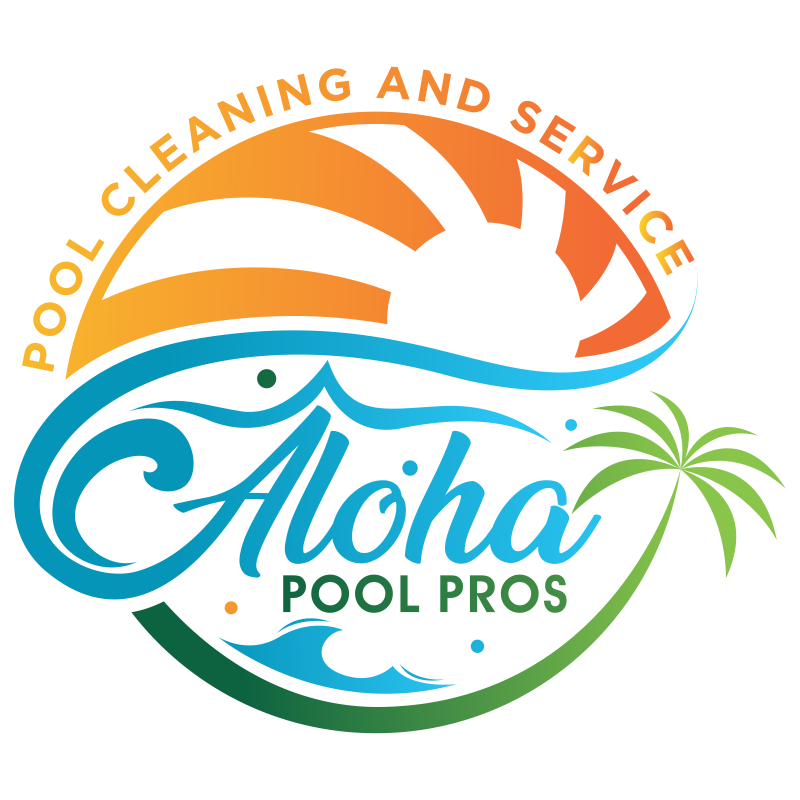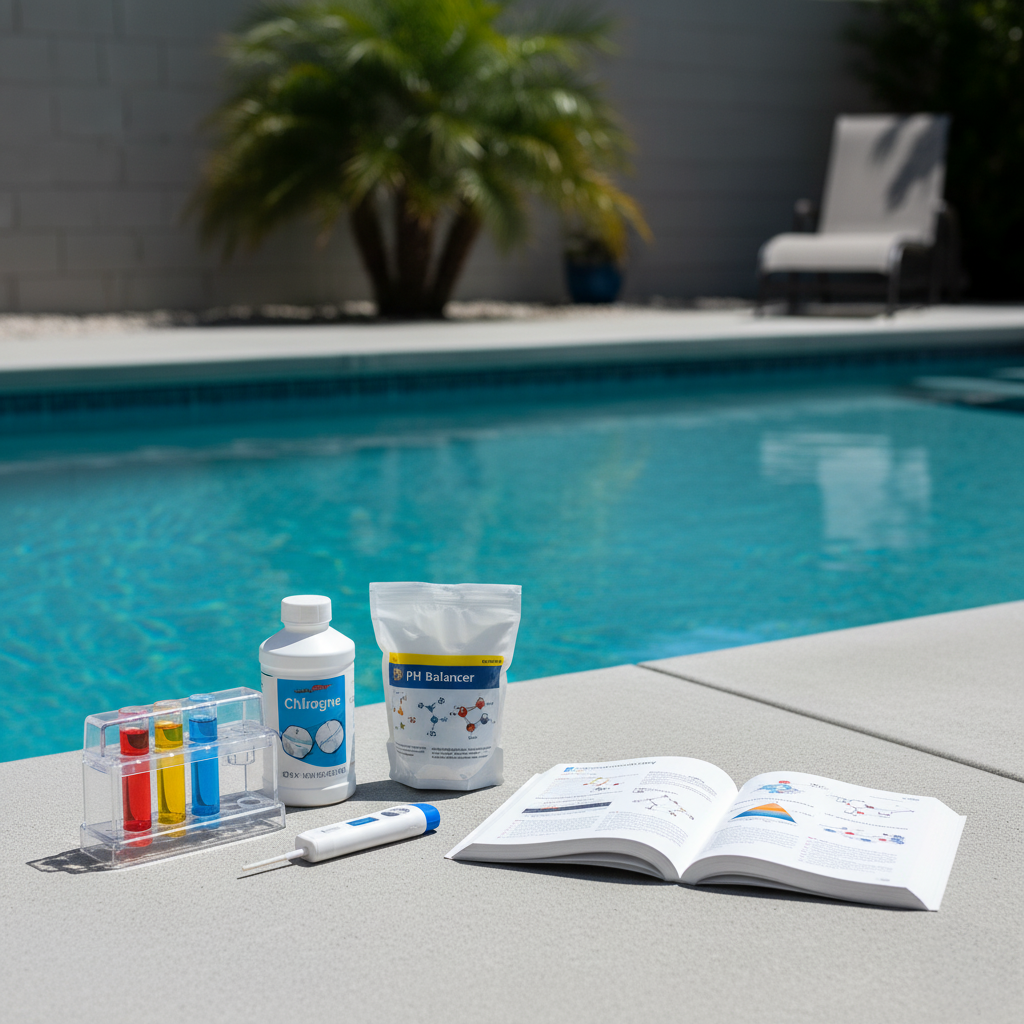A sparkling, safe pool is a backyard paradise. But achieving that perfect shimmer requires a little science. At Aloha Pool Pros, we know that understanding your pool’s chemistry—what chemicals are needed and when to add them—is the foundation of worry-free swimming.
Whether you have a traditional chlorine pool or the soft luxury of a saltwater system, this detailed guide breaks down the essential chemicals and a simple maintenance schedule to keep your water balanced, healthy, and inviting all year long.
The Core Pool Chemistry Pillars (For All Pools)
Regardless of your sanitation method (chlorine or salt), all pool water must be tested and balanced to ensure sanitizer effectiveness, swimmer comfort, and equipment longevity.
1. pH: The Acidity/Alkalinity Balance
- What it is: The measure of how acidic or basic your water is. The scale runs from 0 (acidic) to 14 (basic/alkaline), with 7.0 being neutral.
- Ideal Range: 7.4 – 7.6. This range is optimal for both chlorine effectiveness and swimmer comfort (matching the pH of human tears).
- When to Add:
- Low pH (below 7.4): Water is acidic, which can corrode equipment, etch surfaces, and cause eye/skin irritation. Add a pH Increaser (like soda ash).
- High pH (above 7.6): Water is alkaline, which decreases the effectiveness of chlorine and can lead to cloudy water and scale formation. Add a pH Decreaser (like muriatic acid or sodium bisulfate).
- Testing Frequency: Daily or 2-3 times per week, especially during peak season or after heavy rain.
2. Total Alkalinity (TA): The pH Buffer
- What it is: The measure of alkaline substances in your water that act as a buffer to stabilize the pH level, preventing rapid swings. Think of it as pH’s bodyguard.
- Ideal Range: 80 – 120 ppm (parts per million).
- When to Add:
- Low TA (below 80 ppm): Causes pH to “bounce” erratically and can lead to corrosive water. Add an Alkalinity Increaser (like sodium bicarbonate, or baking soda).
- High TA (above 120 ppm): Makes pH difficult to adjust and can cause cloudy water. Add a pH Decreaser (the acid will lower both TA and pH).
- Testing Frequency: Weekly.
3. Calcium Hardness (CH): Protecting Your Surfaces
- What it is: The measure of dissolved calcium in your water. This protects your pool’s surfaces and equipment from damage.
- Ideal Range: 200 – 400 ppm (varies by pool surface—plaster pools prefer the higher end).
- When to Add:
- Low CH (Soft Water): Water becomes corrosive and will try to leach calcium from your pool plaster, grout, and equipment (called “etching”). Add a Calcium Hardness Increaser.
- High CH (Hard Water): Can lead to calcium scaling (white, crusty deposits) on surfaces and equipment. This typically requires partially draining and refilling the pool with fresh water.
- Testing Frequency: Monthly or seasonally.
4. Cyanuric Acid (CYA): The Sunscreen
- What it is: Also known as stabilizer or conditioner, CYA acts like sunscreen for your chlorine, protecting it from breaking down quickly in the sun’s UV rays.
- Ideal Range: 30 – 50 ppm for traditional chlorine pools, and often slightly higher (60 – 80 ppm) for saltwater pools (to protect the constantly-generated chlorine).
- When to Add: If your level is low. Add Stabilizer/CYA directly to the water or via the skimmer. Important: CYA is consumed very slowly and does not evaporate; once your level is set, it rarely needs adjusting unless you add a significant amount of fresh water.
- Testing Frequency: Monthly or seasonally.
Chlorine Pools: Your Sanitation Powerhouse
Traditional chlorine pools rely on manually adding chlorine in tablet, granular, or liquid form to sanitize the water.
| Chemical | What to Add | When & How Often | Ideal Range |
| Free Chlorine (FC) | Tablets (Triclor): For continuous, slow release. Placed in a floater or automatic feeder. | Daily/Continuously | 1 – 3 ppm |
| Liquid/Granular (Dichlor/Liquid Shock): To raise chlorine levels fast. | As needed based on testing. | ||
| Pool Shock | Cal-Hypo or Non-Chlorine Shock | Weekly, or after heavy use/rain. This removes combined chlorine (chloramines) and kills bacteria. |
Important Chlorine Notes:
- Stabilized vs. Unstabilized: Chlorine tablets (Triclor) contain CYA (stabilizer), while Liquid Chlorine and Cal-Hypo shock do not. Be mindful of this to prevent your CYA from getting too high.
- Shocking: Always shock your pool at dusk or night. The sun’s UV rays will destroy the shock chemical before it can fully work.
Saltwater Pools: Automated & Gentle Sanitation
A common misconception is that saltwater pools are chlorine-free. They are not! They simply use a Salt Chlorine Generator (SWG) to convert pool-grade salt ($\text{NaCl}$) into chlorine ($\text{HOCl}$) via a process called electrolysis. This results in a continuous, consistent, and gentle supply of fresh chlorine.
| Chemical | What to Add | When & How Often | Ideal Range |
| Pool-Grade Salt | High-Purity Salt | Seasonally or as needed when the generator indicates a low salt reading. | 2,700 – 3,500 ppm (Check your generator’s specific recommendation). |
| Free Chlorine (FC) | The SWG produces this continuously. | Continuously by the generator. | 1 – 3 ppm |
| pH Decreaser | Muriatic Acid or pH Minus | Weekly or Bi-Weekly. Salt systems naturally raise the pool’s pH, so acid additions are often more frequent. | 7.4 – 7.6 |
| Pool Shock | Liquid Chlorine or Non-Chlorine Shock | Rarely, as needed. You only need to shock if the SWG cannot keep up (e.g., after a party or storm), or if you need a quick chlorine boost. |
Important Saltwater Notes:
- Salt Level: The salt level is very stable since salt does not evaporate. You only lose salt when water splashes out, or you drain/backwash your pool.
- pH Management: The single most common issue in saltwater pools is chronically high pH. Frequent monitoring and addition of an acid are critical to keep the chlorine working effectively.
- Cell Cleaning: The titanium plates in the salt cell need to be inspected and cleaned periodically (usually 1–4 times per year) with a mild acid solution to remove calcium scale buildup.
When to Add Chemicals: The Golden Rules
- Test First! Never guess. Use a reliable test kit or strips to know exactly what your water needs.
- Add in Order: To maximize effectiveness, it’s best to adjust chemicals in this sequence:
- Alkalinity
- pH
- Calcium Hardness/CYA
- Sanitizer (Chlorine/Shock)
- One at a Time: Wait at least 4-8 hours (and often run your pump for a full circulation cycle) between adding major chemicals to allow each one to fully mix, circulate, and affect the water chemistry. The only exception might be adding a sanitizer after pH/Alkalinity adjustment.
- Circulate: Always ensure your pool pump is running for full circulation when adding chemicals. Pour liquids slowly in the deep end or near a return jet to disperse quickly.
- Read the Label: Always follow the specific instructions and dosages on the chemical packaging.
Let Aloha Pool Pros Handle the Science
Pool chemistry can be complex, especially with Florida’s heat, heavy usage, and sudden storms. If balancing your pool water feels like a chore, let the experts at Aloha Pool Pros take over.
We specialize in expert water testing, chemical balancing, and full-service pool maintenance for both chlorine and saltwater systems, ensuring your pool is always safe, clear, and perfectly balanced.
Aloha Pool Pros proudly services the communities of Melbourne, Florida, Viera, Florida, and Suntree, Florida.
Contact us today to schedule your worry-free pool service at 321-364-0333 or visit us online at alohapoolpros.com

